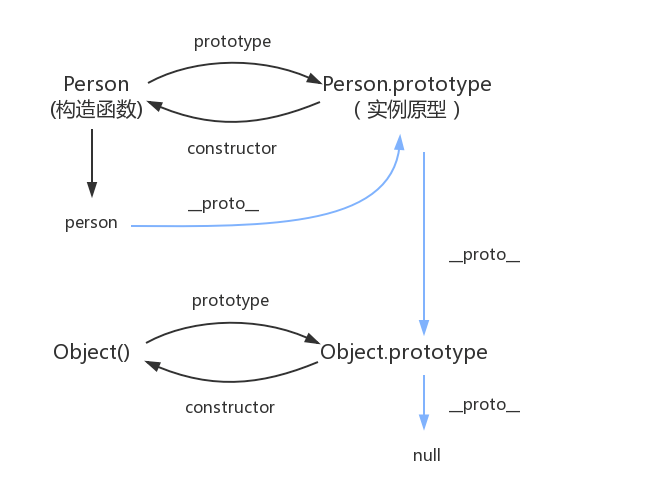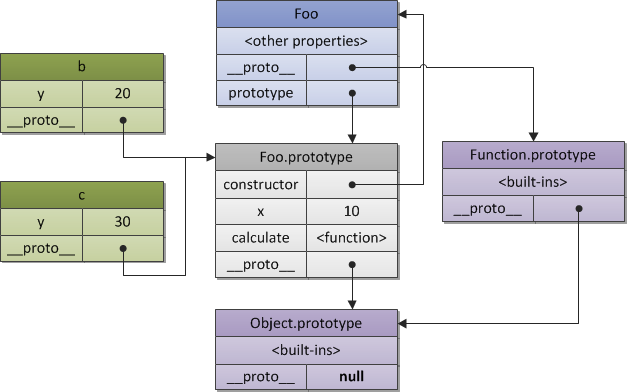# 原型
每一个 js 对象(null 除外)在创建的时候就会有与之关联的另一个对象,这个对象就是我们所说的原型。 每一个对象会从原型上继承属性
如果是通过对象字面量创建的对象其原型指向 Object.prototype
var p = {
name: "hello",
};
console.log(p.__proto__ === Object.prototype); // true
2
3
4
5
通过构造函数创建对象,会自动为实例设置原型对象 p.proto === Person.prototype
function Person() {}
p.name = "hello";
Person.prototype.name = "world";
console.log(p.name); // hello;
delete p.name;
console.lg(p.name); // world
2
3
4
5
6
虽然删除了实例上的 name, 但是原型上仍然能访问到 name

function Person() {}
var p = new Person();
console.log(p.__proto__ === Person.prototype); // true
// 通过ES6提供的 getPrototypeOf 方法获取对象原型
console.log(Object.getPrototypeOf(p) === Person.prototype); // true
console.log(Person === Person.prototype.constructor); // true
console.log(p.constructor === Person); // true
2
3
4
5
6
7
8
9
10
通过上面的代码我们可以知道,实例 p 的 __proto__ 属性执向原型对象;
原型对象 Person.prototype 上的 constructor 属性执向构造函数,
注意最后一行 p.constructor === Person 因为实例 p 上面是没有 constructor 属性的,
所以就会去它的原型上去找,因为原型 Person.prototype 有 constructor 属性,
所以 p.constructor === Person 成立
一开始说到,每一个对象(null 除外)在创建的时候都会有原型对象,那么 原型对象 是否也有一个自己的原型对象呢?
// 打印 Person.prototype 的原型对象
console.log(Person.prototype.__proto__ === Object.prototype); // true
2
Person.prototype 的原型对象其实就是 Object 的原型 Object.prototype,
而 Object.prototype 的原型则为 null 表示没有原型,因此查找属性的时候,
查到 Object.prototype 也就结束了
# proto (也可[[prototype]]这样表示)
__proto__ 是一个非标准的方式访问原型,一般我们我们通过 Object.getPrototypeOf(obj) 来获取对象的原型
# 原型链

图中构造函数 Foo 中的 __proto__ 属性指向 Function.prototype
# 继承
# 原型链继承
将子类的原型指向父类的实例
function SuperType() {
this.name = "super";
this.colors = ["blue", "red"];
}
function SubType() {}
SubType.prototype = new SuperType();
var sub1 = new SubType();
sub1.colors.push("green");
var sub2 = new SubType();
2
3
4
5
6
7
8
9
# 缺点
原型中的 引用类型属性 是会被所有实例共享的,因此这种继承方式也存在这个问题;这里的
colors属性(也就是SubType prototype的属性)是被实例sub1和sub2共享的对sub1.colors进行修改,也会影响到sub2.colors另外不能向超类构造函数中传递参数
# 借用构造函数
通过在子构造函数中调用父类构造函数
function SuperType(name) {
this.name = name;
this.colors = ["blue", "red"];
}
function SubType(name) {
SuperType.call(this, name);
}
var sub1 = new SubType("sub1");
sub1.colors.push("green");
var sub2 = new SubType("sub2");
2
3
4
5
6
7
8
9
10
SuperType.call(this, name) 中的 this 指向的是 SubType , 所以父类构造函数中
的属性会被创建在 SubType 上, 虽然这种方式,可以实现向父类构造函数中传递参数,但是无法访问
父类原型上的方法,如果方法都定义在构造函数中,那边无法做到函数的复用
# 组合继承(原型连继承+借用构造函数)
组合继承结合原型链继承和借用构造函数两者的优点
function SuperType(name) {
this.name = name;
this.colors = ["blue", "red"];
}
SuperType.prototype.getName = function () {
return this.name;
};
function SubType(name) {
SuperType.call(this, name);
}
SubType.prototype = new SuperType();
var sub1 = new SubType("sub1");
sub1.colors.push("green");
var sub2 = new SubType("sub2");
2
3
4
5
6
7
8
9
10
11
12
13
14
15
这种继承方式的缺点在于,无论如何都会调用 2 次父类构造函数: 一次赋值给子类原型时; 一次子类构造函数中 带来了不必要的开销
# 原型式继承(Object.create)
通过 Object.create 将一个对象作为一个新对象的原型,然后创建这个对象的实例返回 这种继承方式和原型链继承没什么差别,也存在相同问题
function create(o) {
function F() {}
F.prototype = o;
return new F();
}
var person = {
name: "haha",
colors: ["green", "blue"],
};
var p1 = create(person);
2
3
4
5
6
7
8
9
10
# 寄生组合式继承 (最理想的继承方式)
避免了超类构造函数 2 次调用,
// subType 子类构造函数
// superType 超类构造函数
function inherit(SubType, SuperType) {
var prototype = Object.create(SuperType.prototype);
prototype.constructor = SubType;
SubType.prototype = prototype;
}
function SuperType(name) {
this.name = name;
}
SuperType.prototype.getName = function () {
console.log(this.name);
};
function SubType(name) {
SuperType.call(this, name);
this.age = 10;
}
inherit(SubType, SuperType);
// 等同于
// SubType.prototype = SuperType.prototype;
// SubType.prototype.constructor = SubType;
2
3
4
5
6
7
8
9
10
11
12
13
14
15
16
17
18
19
20
21
22
23
24
25